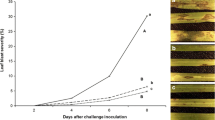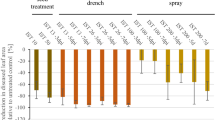Abstract
Several applications of the suppressive fungus MKP5111B, isolated from the phylloplane of rice plants, were tested in an effort to control rice blast disease. Three treatments with MKP5111B [living (Std), killed with liquid nitrogen (FR), and autoclaved (AC)] were either sprayed onto rice seedlings or mixed into seed-sown soil. Three weeks after spraying and 4 weeks after the soil application, we introduced Magnaporthe oryzae, the causal agent of rice blast, into our systems. The Std and FR treatments suppressed rice blast, but the AC treatment proved ineffective. Although a suppressive effect was seen on new leaves, no mycelium of MKP5111B was seen. The fungus thus may have induced a systemic resistance in the rice plants. A substance from MKP5111B, such as elicitor molecule(s) are likely responsible for the induced resistance.




Similar content being viewed by others
References
Alfano JR, Collmer A (1996) Bacterial pathogens in plants: life up against the wall. Plant Cell 8:1683–1698
Arase S, Fujita K (1992) Induction of inaccessibility to Pyricularia oryzae by pre-inoculation of P. grisea in rice leaf-sheath cells. J Phytopathol 134:97–102
Ashizawa T, Zenbayashi K, Sonoda R (2005) Effects of preinoculation with an avirulent isolate of Pyricularia grisea on infection and development of leaf blast lesions caused by virulent isolates on near-isogenic lines of Sasanishiki rice. J Gen Plant Pathol 71:345–350. doi:10.1007/s1032700502161
Couch BC, Kohn LM (2002) A multilocus gene genealogy concordant with host preference indicates segregation of a new species, Magnaporthe oryzae, from M. grisea. Mycologia 94:683–693
Duczek LJ, Jones-Flory LL (1994) Relationship between common root rot, tillering and yield loss in spring wheat and barley. Can J Plant Pathol 15:153–158
Essalmani H, Lahlou H (2003) Bioprotection mechanisms of the lentil plant by Rhizobium leguminosarum against Fusarium oxysporum f. sp. lentis. C R Biol 326:1163–1173 (in French with English summary). doi:10.1016/j.crvi.2003.10.003
Flor HH (1971) Current status of the gene-for-gene concept. Ann Rev Phytopathol 9:275–296
Fujita Y, Sonoda R, Yaegashi H (1990) Leaf blast suppression by pre-inoculation of some incompatible lesion-type isolates of Pyricularia oryzae. Ann Phytopathol Soc Jpn 56:273–275 (in Japanese with English summary)
Fukuhara M (2002) Three Phaeosphaeria species and Paraphaeosphaeria michotii isolated from Phragmites leaves in Osaka, Japan. Mycoscience 43:375–382. doi:10.1007/s102670200055
Gnanamanickam SS, Mew TW (1992) Biological control of blast disease of rice (Oryza sativa L.) with antagonistic bacteria and its mediation by a Pseudomonas antibiotic. Ann Phytopathol Soc Jpn 58:380–385
Grey WE, Mathre DE (1984) Reaction of spring barleys to common root rot and its effects on yield components. Can J Plant Sci 64:245–253
Harrigan GG, Armentrout BL, Gloer JB, Shearer CAJ (1995) Anguillosporal, a new antibacterial and antifungal metabolite from the aquatic fungus Anguillospora longissima. J Nat Prod 58:1467–1469
Iwano M (1987) Suppression of rice blast infection by incompatible strain of Pyricularia oryzae Cav. Bull Tohoku Natl Agric Exp Stn 75:27–39 (in Japanese with English summary)
Kawamata H, Narisawa K, Hashiba T (2004) Suppression of rice blast by phylloplane fungi isolated from rice plants. J Gen Plant Pathol 70:131–138. doi:10.1007/s1032700301009
Kiyosawa S, Fujimaki H (1967) Studies on mixture inoculation of Pyricularia oryzae on rice. I. Effects of mixture inoculation and concentration on the formation of susceptible lesions in the injection inoculation. Bull Nat Inst Agric Sci Tokyo D 17:1–19
Koga H, Kobayashi T (1982) Comparison of the early infection process of Pyricularia oryzae Cav. in rice leaves of compatible and incompatible combinations. Ann Phytopathol Soc Jpn 48:506–513
Knudsen IBM, Hockenhull J, Jensen DF (1995) Biocontrol of seedling disease of barley and wheat caused by Fusarium culmorum and Bipolaris sorokiniana: effects of selected fungal antagonists on growth and yield components. Plant Pathol 44:467–477
Manandhar HK, Lyngs Jorgensen HJ, Mathur SB, Smedegaard-Petersen V (1998) Suppression of rice blast by preinoculation with avirulent Pyricularia oryzae and the nonrice pathogen Bipolaris sorokiniana. Phytopathology 88:735–739
Miyake I (1909) Studies on the parasitic fungi of rice in Japan (in Japanese). Bot Mag (Tokyo) 23:85–97
Ohata K, Kozaka T (1967) Interaction between two races of Pyricularia oryzae in lesion-formation in rice plants and accumulation of fluorescent compounds associated with infection. Bull Nat Inst Agric Sci Tokyo C 21:111–135 (in Japanese with English summary)
Ou SH (1985) Rice diseases, 2nd edn. Commonwealth Mycological Institute, Kew, 380 pp
Reimmann C, Hofmann C, Mauch F, Dudler R (1995) Characterization of a rice gene induced by Pseudomonas syringae pv. syringae: requirement for the bacterial lemA gene function. Physiol Mol Plant Pathol 46:71–81
Shipton WA, Boyd WRJ, Rosielle AA, Shearer BL (1971) The common Septoria diseases of wheat. Bot Rev 37:231–262
Smith JA, Métraux J-P (1991) Pseudomonas syringae pv. syringae induces systemic resistance to Pyricularia oryzae in rice. Physiol Mol Plant Pathol 39:451–461
Taga M, Waki T, Tsuda M, Ueyama A (1982) Fungicide sensitivity and genetics of IBP-resistant mutants of Pyricularia oryzae. Phytopathology 72:905–908
Tsukamoto H, Tsutsumi F, Onodera K, Yamada M, Fujimori T (1999) Biological control of rice leaf blast with Exserohilum monoceras, a pathogen of Echinochloa species. Ann Phytopathol Soc Jpn 65:543–548
Walters D, Newton A, Lyon G (2005a) Induced resistance: helping plants to help themselves. Biologist 52:28–33
Walters D, Walsh D, Newton A, Lyon G (2005b) Induced resistance for plant disease control: maximizing the efficacy of resistance elicitors. Phytopathology 95:1368–1373
Zhang Z, Yuen GY (1999) Biological control of Bipolaris sorokiniana on tall fescue by Stenotrophomonas maltophilia strain C3. Phytopathology 89:817–822
Acknowledgments
We are grateful to Dr. Markus N. Thormann, Natural Resources Canada, Canadian Forest Service, Northern Forestry Centre, Edmonton, Alberta, Canada, for critically reviewing this manuscript.
Author information
Authors and Affiliations
Corresponding author
Rights and permissions
About this article
Cite this article
Ohtaka, N., Kawamata, H. & Narisawa, K. Suppression of rice blast using freeze-killed mycelia of biocontrol fungal candidate MKP5111B. J Gen Plant Pathol 74, 101–108 (2008). https://doi.org/10.1007/s10327-007-0063-3
Received:
Accepted:
Published:
Issue Date:
DOI: https://doi.org/10.1007/s10327-007-0063-3




